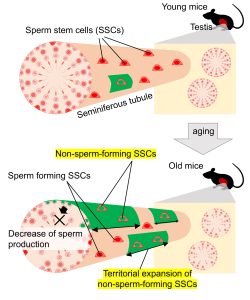How Sperm Stem Cells Change in Older Mice – Some Cells Stop Making Sperm and Spread in the Testes –
We discovered that in aged mice, some sperm stem cells (SSCs)—the cells that normally support sperm production—stop making sperm. These non-sperm-producing SSCs and their descendant cells can still survive, multiply, and move around within the testes.
As these cells increase in number, they take up space that would normally be occupied by sperm-producing SSCs. This may help explain why sperm counts decline as males age.
This research improves our understanding of how aging affects sperm production and may contribute to better treatments for male infertility, as well as help maintain fertility in valuable breeding animals like bulls.

Figure 1: In the seminiferous tubules of the testis, sperm stem cells (SSCs) normally produce sperm. In aged mice, however, some of these cells become non-sperm-forming SSCs, while others remain sperm-forming. The non-sperm-forming SSCs expand their territory within the seminiferous tubules through proliferation and migration, presumably leading to a decrease in sperm production.
【Publication Details】
Title: Age-Dependent Clonal Expansion of Non-Sperm-Forming Spermatogonial Stem Cells in Mouse Testes
Authors: Terumichi Kawahara, Shinnosuke Suzuki, Toshinori Nakagawa, Yuki Kamo, Miki Kanouchi, Miyako Fujita, Maki Hattori, Atsuko Suzuki, Kentaro Tanemura, Shosei Yoshida, Kenshiro Hara
Journal: Aging Cell
DOI: 10.1111/acel.70019.
【Contact】
Kenshiro Hara, Ph.D.
Laboratory of Animal Reproduction and Development, Graduate School of Agricultural Science, Tohoku University
Associate professor
468-1, Aoba, Aramaki-aza, Aoba-ku, Sendai, Miyagi, 980-8572, Japan
Tel: +81-22-757-4306
E-mail: kenshiro.hara.b6@tohoku.ac.jp



